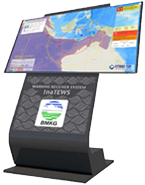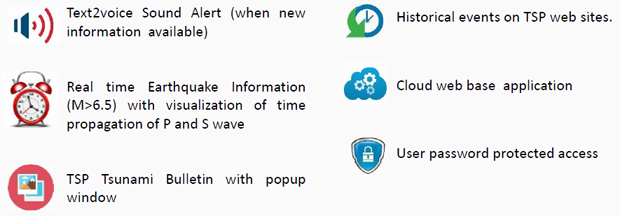Welcome
As a Tsunami Service Provider (TSP) for the Indian Ocean Countries, the Indonesian Tsunami Early Warning System (InaTEWS) offers web access to ocean-wide tsunami warning products.
Registered users may login in order to access warning bulletins issued by TSP Indonesia.
New dissemination mode from TSP Indonesia to NTWCs 

WRS-TSP Indonesia (stands for Warning Receiver System of TSP Indonesia) is the real-time system dedicated to receive earthquake information and tsunami bulletin from TSP Indonesia. WRS-TSP Indonesia connected online directly to the processing and dissemination system of TSP Indonesia at BMKG Jakarta head quarter. WRS-TSP Indonesia is the best solution that can be used as complement or even replacement of existing conventional (SMS, email, fax, GTS) dissemination tool of TSPs. This system use the most current advance technology to distribute information in real-time.
This system is very well displayed on a large screen in the operational room of NTWCs. WRS-TSP Indonesia ensures NTWCs of the Indian Ocean Countries keep informed tsunami bulletin timely and properly. Tsunami bulletin is now in your desk !!. NTWCs could immediately take further essential actions right after they received the tsunami bulletin.

WRS-TSP Indonesia Features

Click here to get user guide of WRS-TSP Indonesia.
The InaTEWS-BMKG functions as an approved Tsunami Service Provider of the IOTWMS that is an integral part of the Global Tsunami Warning and Mitigation System, established and coordinated by the Intergovernmental Oceanographic Commission (IOC) of UNESCO.
Tsunami Programme of IOC-UNESCO
The Tsunami Programme of IOC-UNESCO (http://www.ioc-tsunami.org/), through the coordination of regional meetings, capacity building activities and support of national and regional projects is a key stakeholder for tsunami risk reduction at the global level.
Four Intergovernmental Coordination Groups (ICGs) corresponding to the Pacific Ocean, Caribbean Sea, Indian Ocean, and Northeast Atlantic Ocean & Mediterranean Sea have been established by IOC-UNESCO to address particular regional needs.
Further, to advise the IOC governing bodies on coordinated development of warning and mitigation system for tsunamis and other hazards related to sea level that are of common interest to all the ICGs, the IOC Assembly at it 24th Session (Resolution XXIV-14) established a Working Group on Tsunamis and Other Hazards Related to Sea-Level Warning and Mitigation Systems (TOWS-WG).
Tsunami Warning Service Framework
The end-to-end tsunami early warning and mitigation system consists of Risk Assessment & Reduction, Detection, Warning & Dissemination, and Awareness & Response.
Regional tsunami warning systems operating within different ocean basins are the building blocks of the end-to-end tsunami warning and mitigation system, coordinated by IOC-UNESCO as a global system of systems.
The service framework within each regional tsunami warning system ideally is comprised of National Tsunami Warning Centres (NTWCs) / Tsunami Warning Focal Points (TWFPs) in each Member State receiving tsunami forecast information from one or more Tsunami Service Providers (TSPs).
The TSPs operate 24 x 7 to rapidly detect large earthquakes using real-time seismic networks, assess tsunamigenic potential, monitor tsunami waves using real-time sea-level networks and distribute agreed-upon products to NTWCs/TWFPs operating within the ocean basin or sea.
Ultimately it is the responsibility of mandated national organisations operating within the legal framework of the sovereign nation in which they reside and serve, to provide alerts to their citizens and communities. These alerts are based either on their own analysis of the situation, on the forecast information received from Tsunami Service Providers, or on a combination of both.
Area of Service
The Area of Service of Tsunami Service Providers operating within a regional tsunami warning system are decided by the respective ICGs. The TOWS-WG provides coordination at the global level to ensure coverage to vulnerable coastal regions of participating Member States, while ensuring a high standard of service and inter-operability.
Tsunami Service Providers
The approved Tsunami Service Providers that are currently operating under the IOC-UNESCO framework are given below:
Pacific Tsunami Warning and Mitigation System (PTWS):
1. Pacific Tsunami Warning and Mitigation System (PTWS): http://tsunami.gov/
2. North West Pacific Tsunami Advisory Centre (NWPTAC): http://www.data.jma.go.jp/svd/eqev/data/nwptac/index.html
Caribbean and Adjacent Regions (CARIBE EWS):
1. Pacific Tsunami Warning and Mitigation System (PTWS): http://tsunami.gov/
Indian Ocean Tsunami Warning and Mitigation System (IOTWMS):
1. Joint Australian Tsunami Warning Centre (JATWC): http://www.bom.gov.au/tsunami
2. Indian Tsunami Early Warning Centre (ITEWC): http://www.incois.gov.in/Incois/tsunami/eqevents.jsp
3. Indonesian Tsunami Early Warning System (InaTEWS): http://rtsp.bmkg.go.id
Northeast Atlantic, Mediterranean and Connected Seas (NEAMTWS):
1. French National Tsunami Warning Centre (CENALT): http://www.info-tsunami.fr
2. Institute of Geodynamics, National Observatory of Athens: http://www.gein.noa.gr/en/
3. Kandilli Observatory and Earthquake Research Institute: Turkey, http://www.koeri.boun.edu.tr/2/en
4. National Institute of Geophysics and Volcanology (INGV): Italy, http://www.ingv.it/en/
5. Instituto PortuguÍs do Mar e da Atmosfera (IPMA), Portugal https://www.ipma.pt/en/index.html
Disclaimer:
The tsunami forecast information provided does not originate within IOC-UNESCO. It is provided by InaTEWS-BMKG in support of the IOC-UNESCO IOTWMS. It is the responsibility of mandated national organisations operating within the legal framework of the sovereign nation in which they reside and serve, to provide alerts to their citizens and communities. IOC-UNESCO does not warrant, guarantee, or make any representations regarding the timeliness, currency, correctness, accuracy, reliability, or other aspect of the characteristics or use of the information.

